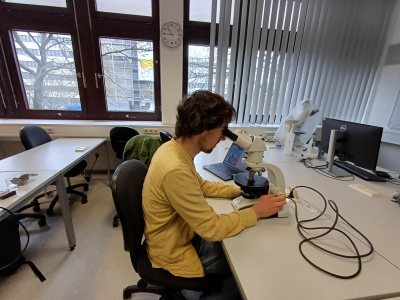- Graduate School GLOMAR
- PhD student reports
- Other activities
- Dennis Schreiber
Dennis Schreiber
Report of GLOMAR PhD student Dennis Schreiber about his participation in the three day course "SEM-based automated mineralogy" at the institute for Geology, University of Münster, Germany organized by Professor Laura Sutenbecker from 20 to 22 February 2024
Scanning Electron Microscopy (SEM) is a technique that uses a focused beam of electrons to scan the surface of a sample, creating a high-resolution image. This course taught a new technique that uses characteristic X-rays that scatter off the sample to map the mineralogy of the sample.
The course began with an introduction by Joachim Krause from the Helmholtz Institute Freiberg for Resource Technology on the physical principles behind scanning electron microscopy and how these can be used to create elemental maps of samples. Sabine Gilbricht from the TU Bergakademie Freiberg explained how these results can be used to create mineralogical maps and discussed the uncertainties that come with this. She showed the different types of microscopes that are capable of performing SEM-based automated mineralogy and provided a detailed introduction of the microscope she operates as a technician at the TU Bergakademie Freiberg.
We practiced the application of SEM-automated mineralogy with case studies of metamorphic rocks, ore deposits and sediments. For me as a sedimentologist, the case studies of sediments were most interesting (although I had great fun refreshing my skills in igneous petrology!). The technique can identify individual grains, albeit with significant uncertainties, by mapping out the boundaries between areas of different compositions. The software can (fully automated) transfer this data into lists of grains and grain sizes, which can be sorted by mineralogical composition. This could complement classic methods of grain size analysis and compositional quantification.
I would like to thank Laura Stutenbecker, Joachim Krause and Sabine Gilbricht for sharing their insights and knowledge during the course. I also extend my gratitude to GLOMAR for enabling me to participate in the course. I learned an incredibly useful technique and gained many ideas for constraining the composition of the samples in my PhD project on tidal cycles and fluvial marine interactions in 3.2-billion-year-old Archean rocks.



